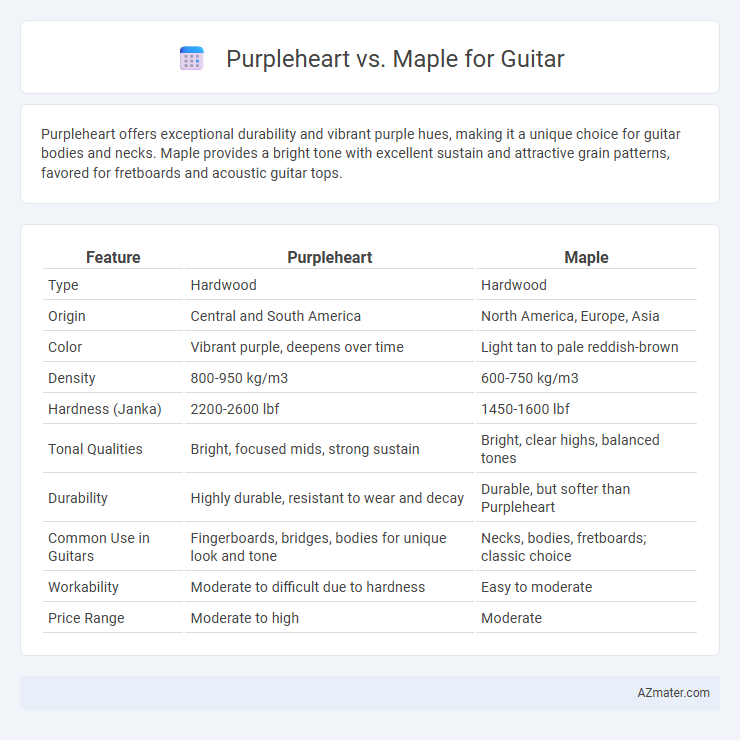Purpleheart offers exceptional durability and vibrant purple hues, making it a unique choice for guitar bodies and necks. Maple provides a bright tone with excellent sustain and attractive grain patterns, favored for fretboards and acoustic guitar tops.
Table of Comparison
| Feature | Purpleheart | Maple |
|---|---|---|
| Type | Hardwood | Hardwood |
| Origin | Central and South America | North America, Europe, Asia |
| Color | Vibrant purple, deepens over time | Light tan to pale reddish-brown |
| Density | 800-950 kg/m3 | 600-750 kg/m3 |
| Hardness (Janka) | 2200-2600 lbf | 1450-1600 lbf |
| Tonal Qualities | Bright, focused mids, strong sustain | Bright, clear highs, balanced tones |
| Durability | Highly durable, resistant to wear and decay | Durable, but softer than Purpleheart |
| Common Use in Guitars | Fingerboards, bridges, bodies for unique look and tone | Necks, bodies, fretboards; classic choice |
| Workability | Moderate to difficult due to hardness | Easy to moderate |
| Price Range | Moderate to high | Moderate |
Introduction to Purpleheart and Maple in Guitar Making
Purpleheart is a dense, hardwood prized for its striking purple hues and durability, making it ideal for guitar components like fingerboards and bridges that demand both strength and aesthetic appeal. Maple, known for its bright tonal qualities and smooth grain, is commonly used for guitar necks and bodies due to its ability to enhance sound clarity and sustain. Both woods offer distinct visual and tonal characteristics, with Purpleheart providing a unique exotic look and Maple delivering classic brightness and resonance in guitar construction.
Characteristics of Purpleheart Wood
Purpleheart wood features a vibrant purple hue that intensifies with exposure to light, providing a unique aesthetic appeal for guitar bodies and necks. This hardwood is known for its exceptional density and hardness, offering excellent sustain and resistance to wear, which enhances tonal stability and durability. Its natural oily texture contributes to smooth playability and reduces the need for extensive finishing, making Purpleheart a favored choice among luthiers seeking both visual distinctiveness and robust performance.
Properties of Maple Wood
Maple wood is highly valued for guitar construction due to its bright tonal characteristics and strong sustain, making it ideal for necks and tops where clarity and projection are essential. Its dense, hard nature provides excellent stability and resistance to wear, contributing to durability and a smooth playing experience. The tight grain pattern of maple also enhances aesthetic appeal, giving guitars a visually striking, glossy finish that remains popular among musicians.
Tone Comparison: Purpleheart vs Maple
Purpleheart wood produces a bright, warm tone with strong midrange presence and excellent sustain, making it ideal for rich, expressive guitar sounds. Maple offers a brighter, more articulate tone with pronounced high frequencies and tight lows, providing clarity and punch in the mix. When comparing Purpleheart vs Maple, Purpleheart emphasizes warmth and depth, while Maple excels in brightness and definition for guitar tone.
Durability and Stability of Each Wood
Purpleheart offers exceptional durability and stability due to its high density and natural resistance to wear, making it ideal for guitar necks and fretboards that withstand intense playing. Maple, renowned for its hardness and stiffness, provides excellent structural stability and impact resistance, ensuring consistent tone and shape retention under varying humidity and temperature conditions. Both woods excel in longevity, but Purpleheart's increased resistance to dents and decay gives it a slight edge in durability compared to Maple.
Weight and Handling Differences
Purpleheart wood is denser than maple, resulting in a heavier guitar body that offers increased sustain and a solid feel during play. Maple, being lighter, provides a more balanced weight distribution, making it easier to handle during long performances or extended practice sessions. The heavier weight of purpleheart may affect player comfort, while maple's lighter nature enhances maneuverability and reduces fatigue.
Aesthetic Appeal: Grain and Color
Purpleheart wood stands out with its rich, deep purple hue that darkens to a warm brown over time, offering a unique and striking visual appeal for guitar bodies and necks. Maple features a lighter, creamy color with prominent, tight grain patterns, often showcasing beautiful flame or quilted figures that add elegance and brightness to the instrument's look. The contrast between Purpleheart's vibrant, exotic coloring and Maple's classic, clean grain makes the choice highly dependent on the desired aesthetic impact of the guitar.
Suitability for Guitar Neck vs Body
Purpleheart offers exceptional density and stability, making it ideal for guitar necks that require durability and resistance to warping under string tension. Maple's bright tonal qualities and smooth grain make it a preferred choice for guitar bodies, enhancing resonance and providing a sleek finish. While Purpleheart provides strong sustain and a unique color for neck construction, Maple balances aesthetics and tonal clarity, favoring body applications.
Price and Availability
Purpleheart wood is generally more expensive than maple due to its rarity and exotic nature, which limits its widespread availability. Maple is commonly found and widely used in guitar manufacturing, making it more affordable and easier to source globally. For guitar builders and buyers prioritizing cost-effectiveness and availability, maple remains the preferred choice, while purpleheart appeals to those seeking unique aesthetics despite higher prices.
Which Wood is Right for Your Guitar?
Purpleheart offers a rich, warm tone with strong midrange emphasis and exceptional durability, making it ideal for players seeking a unique look and resonant sound. Maple provides bright, clear highs and a snappy response, favored for its stability and classic aesthetic in guitar construction. Choosing between Purpleheart and Maple ultimately depends on whether you prioritize tonal warmth and visual uniqueness or clarity and traditional appeal for your guitar's performance.

Infographic: Purpleheart vs Maple for Guitar
 azmater.com
azmater.com